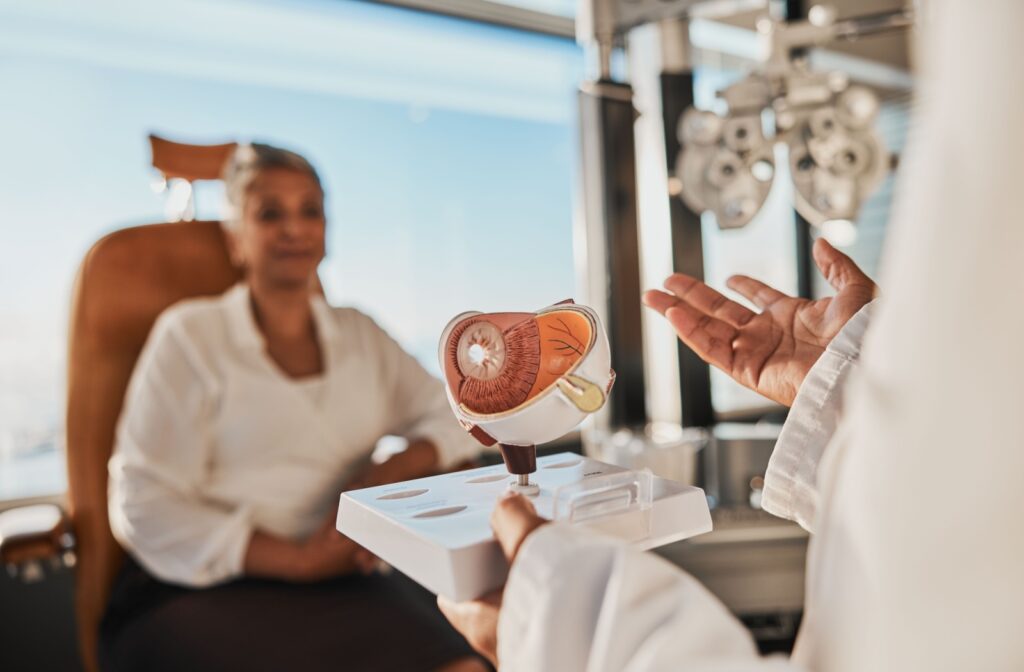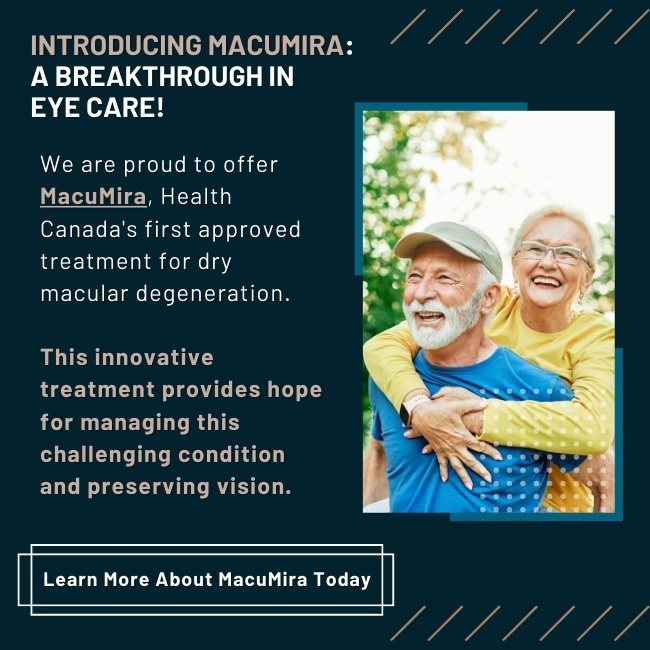Our eyes are constantly challenged throughout the day, whether it’s a hectic schedule filled with hours of screen time or battling our city’s harsh, dry winters.
Sometimes, that tired, scratchy feeling in our eyes isn’t just fatigue but a sign of dry eyes. These are common symptoms, but it may surprise some to know that dry eyes can affect your ability to see clearly.
Dry eyes can result in blurry or fluctuating vision by causing the eye’s surface to become dry, rough, and irregular. This causes incoming light to scatter, preventing it from focusing directly on the retina.
Visiting your eye doctor for a dry eye consultation helps identify the underlying cause of dry eye and develop a personalized management plan, allowing you to experience comfortable, clear vision.
All About Dry Eyes
Dry eyes are a chronic condition where your eyes don’t produce enough tears or poor tear quality prevents proper lubrication of the eye’s surface.
Our tears serve a purpose outside of conveying how we feel. The tear film serves a functional purpose in maintaining eye health.
Tears are made of three layers—oil, water, and mucus—all working together to lubricate the eye’s surface, wash away dust and debris, and act as a barrier against infections.
Dry eyes typically occur when your tear film is out of balance, which can happen in two primary ways:
- Aqueous Deficient Dry Eye: This occurs when your eyes don’t produce enough water-based tears to lubricate the eye. You may have all the necessary components of the tear film, but the tear quality is poor.
- Evaporative Dry Eye: This is the most common form and happens when the oily layer of your tears breaks down, causing the watery layer underneath to evaporate too quickly from the eye’s surface.
This disruption in the tear film can cause an array of dry eye symptoms. Some telltale signs to look out for include:
- Light sensitivity
- Blurry vision
- Stinging, burning, or redness
- A gritty or sandy feeling in your eyes
- Frequent blinking or watery eyes
Dry eyes can be triggered by a wide range of factors, including:
- Aging: Tear production naturally slows down as we get older.
- Screen time: Spending hours staring at digital screens can reduce how often you blink, cutting down tear distribution.
- Environment: Windy or dry climates (no stranger to us Saskatchewanians), pollution, or even your air conditioner can dry out your eyes.
Dry eyes may sound like just an inconvenience. But, they negatively affect your quality of life, making everyday tasks like working on a computer, driving, reading, or even relaxing frustrating and uncomfortable.
While it’s usually not life-threatening, chronic dry eye can lead to serious discomfort and severe complications if left untreated. That’s why managing it proactively is so important!

How Dry Eyes Affect Visual Clarity
Blurry vision and dry eyes often go hand in hand.
For your vision to stay clear, your eyes need a healthy tear film. This creates a smooth corneal surface, allowing light to focus properly on the retina and providing sharp vision.
When the tear film is unstable, the eye’s surface becomes dry, irregular, and rough, causing incoming light to scatter and preventing it from focusing directly on the retina. This results in blurry or fluctuating vision, even if you have 20/20 eyesight or while wearing glasses or contacts.
While corrective lenses are designed to improve visual clarity by refocusing light, they can’t correct disruptions in the tear film.
If you’re an avid contact lens wearer, dryness and blurry vision can feel even worse. Contact lenses rely on a healthy tear layer to stay moist and comfortable. When your eyes are dry, contacts can feel scratchy, making your vision even blurrier.
Dry Eye Management
Dry eyes don’t have a permanent cure but are manageable.
With a mix of lifestyle changes, over-the-counter (OTC) solutions, and advanced therapies, you can reduce symptoms, including blurry vision, and enjoy clearer, more comfortable vision.
Each person’s treatment plan may look different depending on the severity of their symptoms, tear film health, and the underlying cause of dry eyes. Discussing your options with an eye doctor is a great step toward finding a solution that works for you.
At-Home Remedies for Dry Eyes
If you have mild dry eyes, at-home remedies can manage and relieve symptoms:
- Preservative-free artificial tears: These lubricating eye drops mimic natural tears and provide temporary relief. Ensure you are using clinical strength artificial tears.
- Hot compresses: Using a microwavable or electrical eye-safe mask for 5-10 minutes a day can help unclog the glands along your eyelids that produce oil.
- Humidifiers: Adding moisture to the air in your home can prevent your eyes from drying out. Keep the humidity around 40-60%.
- Take breaks: Follow the 20-20-20 rule for screen time. Look at something 20 feet away for 20 seconds every 20 minutes.
- Daily lid cleansing: Using a lid cleaner recommended by your optometrist, gently wipe your lashes in a circular motion.
- Eye-safe products: Use makeup, makeup remover, and skin care that is clean and safe for your eyes.
- Dry eye omega-3 supplements: Foods or supplements rich in omega-3 fatty acids can help improve your tear quality. However, not all omegas are created equal, so we recommend purchasing the dry eye formula available at optometry clinics.
Advanced Therapies
For stubborn or severe dry eye cases, advanced treatments can work wonders by targeting the underlying cause of dry eye for long-term relief:
- Punctal plugs: Tiny devices are inserted into your tear ducts to prevent tears from draining away too quickly.
- ZEST treatments: A gentle gel and applicator are used to exfoliate your lid line, clear tear glands, remove any debris and buildup from your eyelids and lashes, and improve tear stability.
- Radiofrequency: Non-invasive treatment that sends radiofrequency energy to skin tissues. This process heats the meibomian glands to help provide immediate relief to clogged glands and improve function.
- IPL (Intense Pulsed Light): Both devices stimulate and rejuvenate the oil glands, ideal for evaporative dry eye.
- LipiFlow: This device uses thermal pulsation to massage and help unclog oil glands along the eyelids to restore proper function.
- LLLT (Low-Level Light Therapy): Specific wavelengths of red and near-infrared light are used to deliver gentle energy to eye tissues to stimulate the meibomian glands.
Experience Comfortable, Clear Vision
It may seem like a small issue at first, but dry eye’s ability to cause blurry vision can become frustrating and inconvenient. The key to long-term relief is targeting the root cause of dry eyes and finding a proactive approach to management. Connect with our Kennedy Eye Clinic team to schedule a dry eye consultation and develop a plan tailored to your needs!



